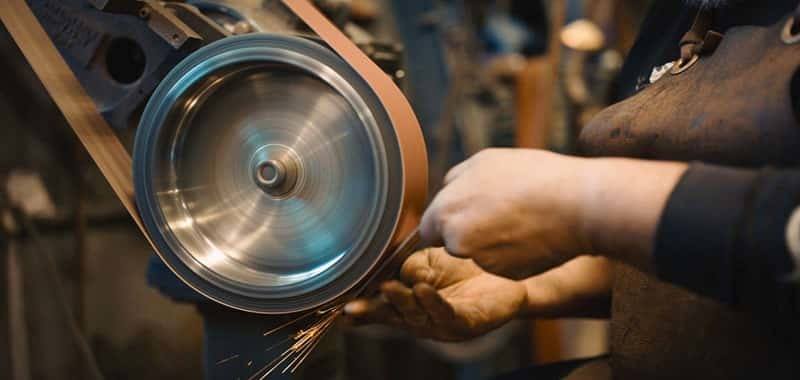Typically, belt sanders are used for scraping off layers of paint fast or to sand down wooden surfaces. But did you know that you can actually sharpen your knives using a belt sander?
You may find yourself second-guessing the idea of using something not meant for metalwork to sharpen a knife, but this idea is not as bizarre as you might be thinking it is, even in theory.
And the article below will hopefully remove all your doubts by showing you the right way of how to sharpen a knife with a belt sander, so you end up with a sharpened knife using an unconventional method.
What You Will Need
Of course, you will need a belt sander and one or more dull knives to start with. Make sure you have varying grits of sandpaper with you, starting from 50, 100, 150, up to 200 grit. The 50 grit will help you get layers of use of the blade quickly, but the 200 one will help your knife achieve ultimate sharpness.
You also want to wear work gloves, preferably ones which are cut-proof. Your knife might be dull when you start, but it will only get sharper and more capable of injuring you.
Sharpening Your Knife Using a Belt Sander
Now here is a step by step of what you need to do in order to get your knife (or chisel) sharp again using a belt sander.
1. Starting the Sharpening Process
Turn up your belt sander’s speed to a maximum while low grit sandpaper is attached to it. 50 grit sandpaper would be ideal as it is coarse and will do the primary sanding well enough.
Hold one side of the blade against the belt sander as it is moving. Make sure they are flat against each other. After a couple of seconds, begin to turn the knife at its edge so that its non-sharp edge faces you at an angle.
You might be tempted to hold the knife in one position for, say, half a minute, but you have to remember that the low grit sandpaper will quickly start eating away at the metal rather than sharpening it.
2. Repeat on the Other Side
As you did before, place the other side of the knife flat against the sander and move it at an angle towards you steadily within 2 seconds. Keep making this motion of increasingly concentrating the sanding effect on the edge of the blade.
Make sure you are holding the knife to the sander properly and that the blade is being sharpened evenly along its length. It will take you only a bit of time to get used to the motion.
3. Increasing the Grit Count
Next, change out the 50 grit sandpaper for something finer like the 100 grit one. The higher the grit count of your sandpaper, the more polished your sharpened blade will be.
Repeat the same motion as before, concentrating on the edge of the blade sideways and moving the knife steadily but within a couple of seconds.
After the 100 grit sandpaper, you will move on to finer grits and will repeat the same motion of sharpening the blade each time until you have a blade with a polished and sharp edge.
Tips about Sharpening Knives on a Belt Sander
While the process of using the belt sander as a knife sharpener is pretty straightforward, here are some things to keep in mind as you do it.
Filing down a Nicked Blade
If your blade has been chipped off in places, then you will need to have a different beginning of the sharpening process.
Before you start with the 50 grit sandpaper on the sanding belt, you will need to file down the nicked edge using a 25 grit paper. This is super coarse sandpaper, which will help you smooth out the unevenness quickly so that you can move on to the finer grits and actually sharpen the knife.
Sharpening a Dented or Twisted Blade
Don’t give up on a blade that is a bit twisted or has dents in it. All you need to do is just follow the steps detailed in the previous section, but for a longer time since you have more area to smooth out.
It may seem undoable, but you can sharpen a dented knife on a belt sander, and it will come out perfectly.
Dampening the Blade during Sharpening
Wetting sandpaper before using it is common practice in woodworking, as it reduces friction and makes the sanding process smoother. You can achieve the same benefits when sharpening your knife on a belt sander by wetting the blade using water before sharpening it.
This will not only make it easier to move the blade along the sander but will also eliminate any unexpected kickbacks from the sander.
Conclusion
So, if you fall into the category of someone who has a belt sander and a dull blade but no whetstone, then we hope you now know exactly how to sharpen a knife with a belt sander.
It’s a simple process to master and one that you can use for years to come.
